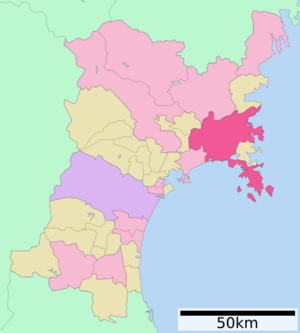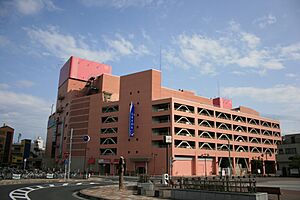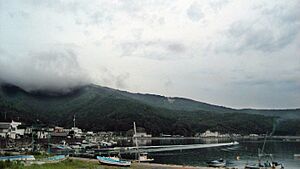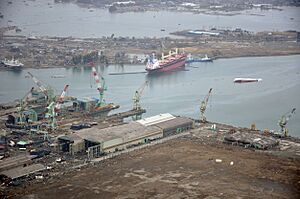Ishinomaki facts for kids
Quick facts for kids
Ishinomaki
石巻市
|
|||||||||||
|---|---|---|---|---|---|---|---|---|---|---|---|

Clockwise from top: View of Mount Kinka from Ojika Peninsula, Makiyama Iris Park, Tashirojima, Ojika Whale Park, Sasa-kamaboko, Ishinomaki Saint John the Apostle Orthodox Church, Mount Hiyori
|
|||||||||||
|
|||||||||||

Location of Ishinomaki in Miyagi Prefecture
|
|||||||||||
| Country | Japan | ||||||||||
| Region | Tōhoku | ||||||||||
| Prefecture | Miyagi | ||||||||||
| First official recorded | 367 AD | ||||||||||
| City Settled | April 1. 1933 | ||||||||||
| Area | |||||||||||
| • Total | 554.55 km2 (214.11 sq mi) | ||||||||||
| Population
(February 2, 2022)
|
|||||||||||
| • Total | 138,538 | ||||||||||
| • Density | 249.8206/km2 (647.032/sq mi) | ||||||||||
| Time zone | UTC+09:00 (Japan Standard Time) | ||||||||||
| Phone number | 0225-95-1111 | ||||||||||
| Address | 14-1 Kokucho, Ishinomaki-shi, Miyagi-ken 986-8501 | ||||||||||
| Climate | Cfa | ||||||||||
|
|||||||||||
Ishinomaki (石巻市 (Ishinomaki-shi)) is a city located in Miyagi Prefecture, Japan. As of February 2, 2022, about 138,538 people live here. The city covers an area of about 554.55 square kilometers.
Contents
Exploring Ishinomaki's Geography
Ishinomaki is in the northeast part of Miyagi Prefecture. It borders Ishinomaki Bay to the south and the city of Minamisanriku to the north. The Kitakami Mountains are to its west.
Coastal Beauty and Islands
Ishinomaki's coastline is part of the Sanriku Fukkō National Park. This park stretches all the way north to Aomori Prefecture. Ishinomaki is also home to some interesting islands:
- Tashirojima, often called "Cat Island" because of its many cats.
- Ajishima
- Kinkasan
These islands are located off the south coast of the Oshika Peninsula.
Nearby Towns and Cities
Ishinomaki is surrounded by several other towns and cities in Miyagi Prefecture:
- Higashimatsushima
- Minamisanriku
- Misato
- Onagawa
- Tome
- Wakuya
Ishinomaki's Climate
Ishinomaki has a humid subtropical climate. This means it has mild summers and cold winters.
- The average yearly temperature is about 11.9°C (53.4°F).
- The city gets about 1091.3 mm (43 inches) of rain each year. September is usually the wettest month.
- August is the warmest month, with temperatures around 23.6°C (74.5°F).
- January is the coldest month, with temperatures around 1.0°C (33.8°F).
- The highest temperature ever recorded was 36.8°C (98.2°F) on August 15, 2007.
- The lowest temperature ever recorded was -14.6°C (5.7°F) on January 6, 1919.
People of Ishinomaki: Demographics
Over the last 40 years, the number of people living in Ishinomaki has slowly gone down.
| Historical population | ||
|---|---|---|
| Year | Pop. | ±% |
| 1920 | 102,953 | — |
| 1930 | 122,589 | +19.1% |
| 1940 | 137,327 | +12.0% |
| 1950 | 177,015 | +28.9% |
| 1960 | 180,012 | +1.7% |
| 1970 | 177,597 | −1.3% |
| 1980 | 186,094 | +4.8% |
| 1990 | 182,911 | −1.7% |
| 2000 | 174,778 | −4.4% |
| 2010 | 160,826 | −8.0% |
| 2020 | 140,151 | −12.9% |
Ishinomaki's Rich History
The area where Ishinomaki is today was once part of an old Japanese province called Mutsu Province. During the Sengoku period (a time of many wars), different samurai families fought over this land. Eventually, the Date clan from Sendai Domain took control during the Edo period.
Ishinomaki became a very important port city. It was a major hub for ships carrying goods between Edo (which is now Tokyo) and northern Japan. The town of Ishinomaki was officially created on June 1, 1889.
The city of Ishinomaki was founded on April 1, 1933. Later, on April 1, 2005, Ishinomaki grew much larger. It absorbed several nearby towns: Kahoku, Kanan, Kitakami, Monou, Ogatsu, and Oshika. This made Ishinomaki's area four times bigger and added almost 60,000 people to its population!
The town of Ogatsu is famous for its inkstones, which are used for traditional Japanese calligraphy. It also has a fun scallop festival every summer. Ayukawa, a town in Oshika, used to be a base for Japan's whaling fleet.
The 2011 Earthquake and Tsunami
Ishinomaki was one of the places hit hardest by the terrible 2011 Tōhoku earthquake and tsunami. Huge waves, some as high as 10 meters (33 feet), crashed inland up to 5 kilometers (3 miles) from the coast. About 80% of the houses in the coastal town of Ayukawa were destroyed. The Kadonowaki area was almost completely wiped out. Nearly half of Ishinomaki city was flooded by the tsunami.
After the tsunami, a statue of the Japanese superhero Kamen Rider was found standing perfectly, even though everything around it was damaged. Many people hoped this would be a symbol of hope for the survivors.
Many schools were destroyed. Sadly, at Ishinomaki Okawa Elementary School (大川小学校), 70 out of 108 students and 9 out of 13 teachers and staff were lost.
Ishinomaki had the highest number of confirmed deaths from the tsunami in Japan. As of June 17, 2011, over 3,000 deaths were confirmed, and many more people were missing. About 29,000 people in the city lost their homes.
The earthquake actually moved the city! It shifted Ishinomaki southeast and pushed it down by as much as 1.2 meters (4 feet) in some places. This caused parts of the city to flood twice a day during high tide. A sandy beach in Kadonowaki disappeared, and the tides now reach a wall that used to be far from the water.
Rebuilding Ishinomaki
Since 2011, Ishinomaki and other towns have been working hard to rebuild and encourage people to return. As a reminder of the tragedy, Okawa Elementary School remains in ruins as a memorial.
Ishinomaki and its neighboring cities have also started building strong levees and large walls along the coast. These structures are designed to protect the area from future tsunamis.
Ishinomaki's Economy
Ishinomaki has always been an important place for commercial fishing. They are especially known for growing oysters.
Education in Ishinomaki
Ishinomaki has many schools for young people:
- 36 public elementary schools
- 20 public junior high schools
- 1 public high school (run by the city government)
- 7 public high schools (run by the Miyagi Prefectural Board of Education)
- 1 special education school for students with disabilities (also run by the prefecture)
There is also a private university in the city called Ishinomaki Senshu University.
Getting Around Ishinomaki: Transportation
Railway Lines
You can travel by train in Ishinomaki using lines operated by East Japan Railway Company (JR East):
- ■Ishinomaki Line
- Maeyachi - Kakeyama - Kanomata - Sobanokami - Ishinomaki - Rikuzen-Inai - Watanoha - Mangoku-Ura - Sawada
- ■Senseki Line (also the ■■Senseki-Tohoku Line)
- Ishinomakiayumino - Hebita - Rikuzen-Yamashita - Ishinomaki
- ■Kesennuma Line
- Maeyachi - Wabuchi
Intercity Buses
You can take buses from Ishinomaki Station to other cities:
- To Sendai: These buses stop at the Aeon Ishinomaki Shopping Center. They are run by Miyakou Bus Co. Ltd.
- To Shinjuku, Tokyo (overnight bus): These buses also stop in Shibuya. They are operated by Miyagi Transportation and Keio Dentetsu Bus Corporation.
Highways
Major roads that pass through Ishinomaki include:
 Sanriku Expressway (Sanriku Expressway)
Sanriku Expressway (Sanriku Expressway) National Route 45
National Route 45 National Route 108
National Route 108 National Route 398
National Route 398
Seaport
The Port of Ishinomaki is an important port for the city.
Fun Places to Visit in Ishinomaki
Ishinomaki has many interesting places to explore:
- Ishii lock: A historical lock system.
- Ishinomaki Saint John the Apostle Orthodox Church: A beautiful church.
- Ishinomori Manga Museum: This museum celebrates the work of famous manga artist Shotaro Ishinomori. You can also walk along Manga Road, which is dedicated to his creations.
- The reed fields at the mouth of the Kitakami River: The sounds here are so special that they are listed as one of the 100 Soundscapes of Japan by the Japanese government.
- Numazu Shell Midden: An ancient site from the Jōmon period.
- Saitō Garden: A lovely garden to visit.
- San Juan Bautista: A replica of a historic Japanese ship. This ship was built in 1613 and was used to send an important group of people to visit the Pope in Rome.
Ishinomaki's Sister Cities
Ishinomaki has special connections with other cities around the world, called "sister cities" or "friendship cities."
Sister City
Friendship Cities
 Civitavecchia, Italy
Civitavecchia, Italy Hagi, Japan
Hagi, Japan Kahoku, Japan
Kahoku, Japan Wenzhou, China
Wenzhou, China
Famous People from Ishinomaki
Many notable people come from Ishinomaki:
- Jun Azumi: A politician.
- Kasugafuji Akihiro: A sumo wrestler.
- Tatsuji Fuse: A lawyer and social activist.
- Sukekiyo Kameyama: A voice actor.
- Isamu Kosugi: An actor and movie director.
- Mai Mukaida: A make-up artist and businesswoman.
- Naoya Shiga: An author.
- Keiko Suzuka: An actress.
- Mayo Suzukaze: An actress.
See also
 In Spanish: Ishinomaki para niños
In Spanish: Ishinomaki para niños







